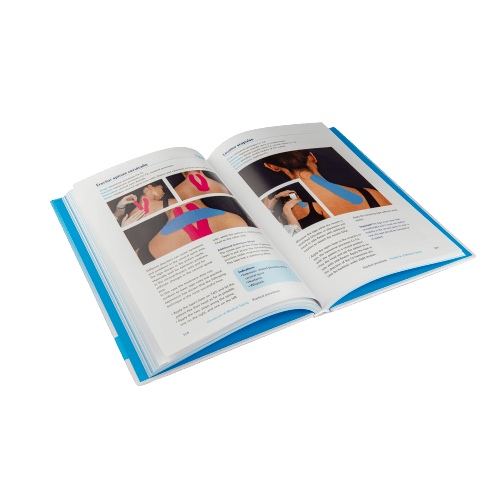Multiple Sclerosis (MS) is a long-term condition affecting the central nervous system, causing disruptions in signal transmission. Typically diagnosed around age 30, MS manifests with various symptoms, notably muscle stiffness, weakness, and lack of coordination. Among the prevalent symptoms are motor difficulties in the hands and fingers, often marked by strength loss, spasticity, and muscle cramps.
Submitted case of Nieuw Unicum, a centre specialised in the treatment of MS patients
In 2017, we asked our clients to participate in the “Show Your Skills” campaign. By sending in a video with a case study showing how kinesiology taping is successfully applied in practice, the participant could win a bespoke taping course in their own practice.
The winner of this promotion is physiotherapist Barbara van Marle, who works at Nieuw Unicum, a centre specialised in the treatment of clients with Multiple Sclerosis. Barbara frequently and successfully applies kinesiology taping with CureTape in her practice. She shares the following case study with us. The beautiful videos show that kinesiology taping is indispensable for these clients and provides relief.
Get started with these items to tape for MS
-
CureTape® Classic Kinesiology Tape
Bestseller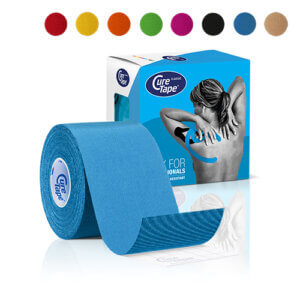 $19.95
In stockSelect options This product has multiple variants. The options may be chosen on the product page
$19.95
In stockSelect options This product has multiple variants. The options may be chosen on the product page -
CureTape® Classic 2.5cm Kinesiology Tape
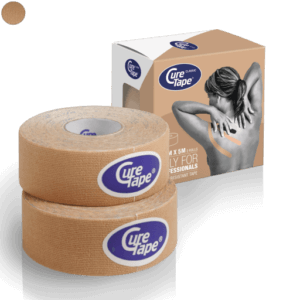 $21.95
In stockAdd to cart
$21.95
In stockAdd to cart -
CureTape® Cutter – Kinesiology tape cutting device
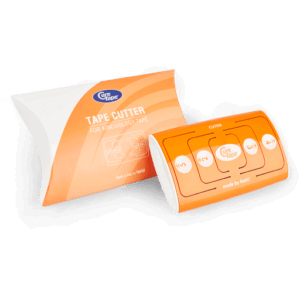 $107.95
In stockAdd to cart
$107.95
In stockAdd to cart -
Standard scissors
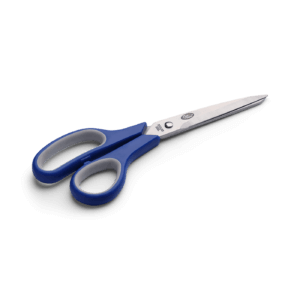 $14.95
In stockAdd to cart
$14.95
In stockAdd to cart
Treatment 1:
Without tape
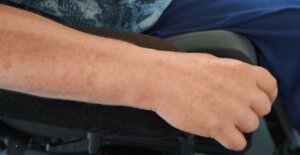
With tape

Tape instruction for stimulating tape on the extensors of the forearm
- Measure the length of the tape from the elbow to the fingertips.
- Then cut the 5 cm tape into 2.5 cm strips (or use CureTape beige 2.5 cm).
- From the wrist, cut this 2.5 cm into two strips of tape.
- Apply the stimulating tape from the epicondyle lateralis over the extensor muscles, at the transition to the hand the tape splits to each finger.
- For the thumb trigger (extensor pollicis longus), use a narrow I tape of 2.5 cm x 15 cm.
Tape instruction for sedative tape on the flexors of the forearm
- Measure the length of the tape from the wrist to the medial epicondyle.
- Use the 5cm wide CureTape for this.
- Apply the tape without stretching in that direction.
- This way, the flexors of the forearm relax.
- The combination of these three tapes ensures that the client can stretch the fingers better again.
Treatment 2:
The patient has a flexion position in the MCP II to V (ball joints at the base of the fingers) as a result of low tonus in the mm. lumbricales. By applying a facilitating (stimulating) tape to the mm. Lumbricales, the client can stretch the fingers better.
Tape instructions:
- Cut 3 strips of I tape 2.5 cm wide and cut an Y from the centre of the tape.
- Apply the first strip of tape from the palm of the hand and spread the small strips between the fingers to the top of the little finger and ring fingers.
- The strips of the second tape are applied on the ring finger and the middle finger.
- Apply the third tape strip on the middle finger and index finger.
- Rub the tape well to improve adhesion.
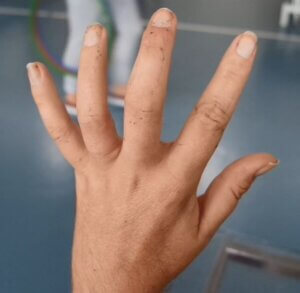
Without tape
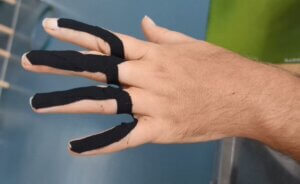
With tape
Learn how to tape
Want to learn how to apply tape yourself*? Check out our manuals on taping:
- The Ultimate Taping Guide: Focuses on self-taping for the 30 most common injuries where taping provides support.
- Kinesiology Taping Method Manual: Designed for (para medical) professionals, covering basic taping techniques and various pathologies.
- Decompressive Taping Techniques Manual: Specifically focuses on lymphatic taping methods for decompression.
What are you waiting for? Order a copy today!
THYSOL is the manufacturer of the kinesiology tape brand CureTape. As CureTape, we have been training and supplying professionals for 25 years. And consumers now know how to find us too! By manufacturing all our tapes in our own factory, we can guarantee the best quality!
Please note that the indicated tape applications and information on our website about the possibilities with kinesiology tape have not yet been scientifically proven. The statements and examples mentioned are based on long-term experiences of patients and trained therapists.Contraindications not to tape: pregnancy, open wounds, broken bones, unexplained complaints, allergies and skin diseases, use of medication such as blood thinners, thrombosis and fever. Always apply tape in consultation with a specialist.

